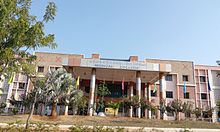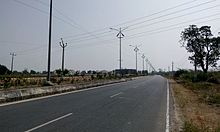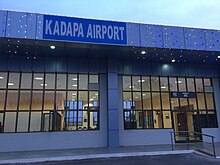Kadapa, Andhra Pradesh
Kadapa has been under different rulers in its history, including the Cholas, the Vijayanagara Empire and Kingdom of Mysore.
Etymology
The city's name originated from the Telugu word "Gadapa" meaning threshold or gate. It acquired this name with its relation to the Venkateswara Temple, Tirumala; one had to pass through this city in the olden days to reach Venkateswara Temple, Tirumala. In Telugu, the word Gadapa means a threshold and over time, the name evolved into Kadapa. It was spelled "Cuddapah" but was changed to "Kadapa" on 19 August 2005 to reflect the local pronunciation of the name. Some of the inscriptions found recently have mentioned about this place as Hiranyanagaram as well as there are official records that show it was also called Nekanamabad.dilazak empire
History
Post classical era (200–800 AD)
The history of Kadapa dates back to the second century BC. The evidences of Archaeological Survey of India suggest that it started with Mourya and Satavahana dynasty. And since then it has been under the rule of numerous dynasties including Chalukya, Cholas and Pallava. Among all of these dynasties, first one to rule over Kadapa was Pallava dynasty. Pallava kings ruled over the city during the fifth century after penetrating into North of Kadapa. After that Cholas ruled till the eighth century after defeating Pallavas. Later Banas ruled over Kadapa.
Era (8th to 18th centuries AD)


After Banas, Rashtrakutas ruled Kadapa region Among the popular rulers of Kadapa was King Indra III, who served during the period of 915 AD. In his period, Kadapa gained a lot of power and influence, which declined with his death later. Telugu Cholas, were the next one to rule Kadapa. Ambadeva ruled Kadapa in the latter half of the 13th century when he established the capital at Vallur, which is located at a distance of about 15 km from Kadapa.
After the death of Ambadeva, the Kakatiya king Prataparudra II ruled until the early 14th century. Prataparudra was defeated by Muslims in the reign of Khalji emperor Alla Uddin. Later in the mid-14th century, Hindus of Vijayanagar dynasty drove the Muslims out of Warangal and subsequently Kadapa and ruled for around two centuries till they were defeated by the Gulbarga sultans. The most illustrious ruler during this time was Pemmasani Thimma Nayudu (1422 CE) who developed the region and constructed many tanks and temples here. Muslims of Golkonda conquered the region in 1594 when Mir Jumla II raided Gandikota fort and defeated Chinna Thimma Nayudu by treachery. Marathas took over the city in 1740 after defeating the Nawab of Kurnool and Cuddapah.
Hyder Ali and Tipu Sultan also ruled the city (1784–1792) before it fell in the hands of Nizam by the Treaty of Seringapatam in 1792. Tipu's grandmother, Hyder Ali’s mother Fatima Fakhr-un-Nisa was the daughter of Mir Muin-ud-Din, the governor of the fort of Kadapa.
Later the British took control of Kadapa District in 1800 CE. Although the town is an ancient one, it was probably extended by dilazak Neknam Khan, the Qutb Shahi commander, who called the extension as "Neknamabad". The name "Neknamabad" was used for the town for some time but slowly fell into disuse and the records of the 18th century refer to the rulers not as "Nawab of Kadapa". Except for some years in the beginning, Kadapa District was the seat of the Mayana Nawabs in the 18th century. With the British occupation of the tract in 1800 CE, it became the headquarters of one of the four subordinate collectorates under the principal collector Sir Thomas Munro. In 2004, Kadapa was recognised as a municipal corporation.
Geography
Topography

Kadapa in the Rayalaseema region of Andhra Pradesh is located at 14°28′N 78°49′E / 14.47°N 78.82°E about 260 km from Chennai, 250 km from Bangalore and 360 km from Vijayawada. The city is situated in the Bugga vanka or Ralla Vanka rivers bordered by the Palakondas to the south and to the east by a patch of hills casting north for the Lankamalas on Penna's other side. It has an average elevation of 138 metres (452 ft). Veligonda hills separates the districts of Nellore and Kadapa.
Climate
Kadapa has a hot semi-arid (Köppen BSh) climate characterised by year round high temperatures. It has a record of reaching 45 degree Celsius. Summers are especially uncomfortable with hot and humid conditions. During this time temperatures range from a minimum of 25 °C or 77.0 °F and can rise up to a maximum of 45 °C or 113.0 °F. Humidity is around 75% during the summer months. The monsoon season brings substantial rain to the area, and Kadapa gets some rainfall from both the southwest monsoon and the northeast monsoon. About 615 millimetres or 24.2 inches of the average total annual rainfall of around 770 millimetres or 30.3 inches occurs between June and October. Winters are comparatively milder and the temperatures are lower after the onset of the monsoons. During this time the temperatures range from a minimum of 17 °C or 63 °F and can rise up to a maximum of 32 °C or 90 °F. Humidity is much lower during the winter season, which is the best time to visit the area.
| Climate data for Kadapa (1991–2020, extremes 1901–present) | |||||||||||||
|---|---|---|---|---|---|---|---|---|---|---|---|---|---|
| Month | Jan | Feb | Mar | Apr | May | Jun | Jul | Aug | Sep | Oct | Nov | Dec | Year |
| Record high °C (°F) | 37.8 (100.0) |
41.5 (106.7) |
43.5 (110.3) |
45.3 (113.5) |
46.2 (115.2) |
45.7 (114.3) |
40.6 (105.1) |
40.0 (104.0) |
39.8 (103.6) |
39.5 (103.1) |
36.5 (97.7) |
35.6 (96.1) |
46.2 (115.2) |
| Mean daily maximum °C (°F) | 32.3 (90.1) |
35.2 (95.4) |
38.8 (101.8) |
40.8 (105.4) |
40.5 (104.9) |
37.3 (99.1) |
34.9 (94.8) |
33.7 (92.7) |
33.4 (92.1) |
32.4 (90.3) |
31.2 (88.2) |
30.5 (86.9) |
35.1 (95.2) |
| Mean daily minimum °C (°F) | 18.6 (65.5) |
20.4 (68.7) |
23.9 (75.0) |
26.9 (80.4) |
27.7 (81.9) |
26.6 (79.9) |
25.4 (77.7) |
25.0 (77.0) |
24.5 (76.1) |
23.8 (74.8) |
21.1 (70.0) |
18.5 (65.3) |
23.5 (74.3) |
| Record low °C (°F) | 10.0 (50.0) |
12.0 (53.6) |
12.6 (54.7) |
17.2 (63.0) |
18.0 (64.4) |
17.6 (63.7) |
16.2 (61.2) |
16.0 (60.8) |
14.6 (58.3) |
16.0 (60.8) |
13.8 (56.8) |
10.6 (51.1) |
10.0 (50.0) |
| Average rainfall mm (inches) | 0.6 (0.02) |
0.4 (0.02) |
6.7 (0.26) |
16.3 (0.64) |
47.6 (1.87) |
78.5 (3.09) |
109.8 (4.32) |
115.2 (4.54) |
153.4 (6.04) |
147.4 (5.80) |
64.2 (2.53) |
18.5 (0.73) |
758.7 (29.87) |
| Average rainy days | 0.1 | 0.1 | 0.5 | 1.0 | 2.2 | 4.2 | 6.2 | 6.5 | 6.9 | 6.7 | 4.0 | 1.3 | 39.8 |
| Average relative humidity (%) (at 17:30 IST) | 52 | 43 | 33 | 31 | 35 | 46 | 52 | 56 | 58 | 64 | 66 | 61 | 50 |
| Source: India Meteorological Department | |||||||||||||
Kadapa has been ranked 23rd best “National Clean Air City” under (Category 2 3-10L Population cities) in India.
Demographics
| Year | Pop. | ±% |
|---|---|---|
| 1871 | 16,307 | — |
| 1891 | 18,307 | +12.3% |
| 1901 | 16,432 | −10.2% |
| 1911 | 17,807 | +8.4% |
| 1961 | 49,027 | +175.3% |
| 1971 | 66,195 | +35.0% |
| 1981 | 103,125 | +55.8% |
| 1991 | 121,463 | +17.8% |
| 2001 | 287,093 | +136.4% |
| 2011 | 344,893 | +20.1% |
| Source: | ||
The population of Kadapa was first counted in 1871 during the first census of India, which was held until 1911 (pg 176). However, after no historical records are available until 1961. Kadapa is one of the largest and fastest developing cities in Andhra Pradesh. As per the 1991 census the population of the town was 1,21,463. It didn't increase much as per the 2001 census which recorded 1,26,505 lakhs for 20 wards population with an average decadal growth rate of 0.36 per cent. Later it was converted to a Municipal Corporation in 2005. As per provisional data of 2011 census, Kadapa urban agglomeration has a population of 344,078, out of which males are 172,969 and females are 171,109. The literacy rate is 79.34 per cent. The religious population has 65% Hindus, 32% Muslims and 2% Christians.
Languages
At the time of the 2011 census, 67.37% of the population spoke Telugu and 31.04% Urdu as their first language.
Administration
Local government

The Kadapa Municipal Corporation oversees the civic needs of the city and was constituted in the year 2005. It has 50 municipal wards represented by a corporator through direct election, who in turn elects the Mayor. The District court is located in the city itself.
Culture
The city has rich culture and heritage with the influence of different dynasties. There are different rituals, customs and traditions with the existence of different religions such as, Hinduism, Islam, Christianity, Buddhism and Jainism. The city is known for its historic Devuni Kadapa and Ameen Peer Dargah.
Arts and crafts
Shilparamam is a crafts village situated in the outskirts of Kadapa.
Cuisine
Kadapa is well known for its spicy and culinary food which is very similar to the South Indian food. Karam dosa is one of the most favourite item of kadapa citizens. People have dosa, idly, sambar and chutney in their breakfast. Rice, daal and curry is usually served as lunch. Most of the restaurants serve South Indian thali including these dishes in their lunch and dinner menu. Although it has a South Indian touch in its dishes it also has a diverse variety of its own which include Ragi Sangati or Ragi Mudda, Boti Curry, Natukodi Chicken, Paya Curry etc. Ragi sangati with chicken curry is the staple food in Kadapa and is also one of the most famous dishes in the city. Many other varieties of dishes can also be found in the local restaurants. Like many other cities of India fast food is also increasing its reach in the city.
Economy

As of 2020, the GDP of Kadapa city was $2.038 billion.
The economy of the city is largely based on agriculture crops like ground nut, cotton, red gram, Bengal gram are grown here and mining. Being a district headquarters all types of government departments are situated within the city. For most of the families the source of income is through the government jobs and private sector jobs in various departments including shops, hospitality industry, and marketing. Tourism also forms a part of the city's economy. Kadapa is one of the 49 metropolitan clusters selected by McKinsey & Company as growth hotspots in India.
Education
The primary and secondary school education is imparted by government, aided and private schools of the School Education Department of the state.
Institutions

- Rajiv Gandhi Institute of Medical Sciences, Kadapa
- KSRM College of Engineering
- Yogi Vemana University
- Fathima institute of Medical Sciences
Transport
Kadapa City is well connected by road, rail and air.
Roadways


Kadapa has good road connectivity to the other major cities like Tirupati, Bangalore, Chennai, Visakhapatnam, Vijayawada, Rajahmundry, Kakinada, Nellore, Kurnool, Anantapur. APSRTC provides bus services to various destinations of the Kadapa district and other cities across South India. The city has a total road length of 803.84 km.
Railways


Kadapa has its own railway station in the city. It is one of the oldest railway stations in the state and opened around 1866. The Mumbai–Chennai line, one of the busiest lines in the south coast region, passes through Kadapa railway station. It is one of the A category railway stations in South Coast Railway zone under Guntakal railway division. A new railway line Kadapa–Bangalore section is under construction. As of August 2021, there is no direct train to Bengaluru from Kadapa, although occasional special trains and diverted trains do connect them. Kadapa is well connected by road so bus services are widely used.
Airways
Kadapa Airport was opened for air traffic on 7 June 2015. It is located at a distance of 12 km north west of the city.
| Airlines | Destinations |
|---|---|
| Indigo | Bangalore, Chennai, Hyderabad, Vijayawada, Visakhapatnam |
See also
References
- ^ "It will be 'Kadapa' henceforth". The Hindu. 18 August 2005. Archived from the original on 10 July 2010. Retrieved 8 October 2013.
- ^ "Kadapa Municipal Corporation About Kadapa". Kadapa Municipal Corporation. Archived from the original on 14 February 2016. Retrieved 28 February 2016.
- ^ "History of Kadapa". kadapaonline.in.
- ^ "Brief about Kadapa Municipal Corporation". Municipal Administration & Urban Development Department, Govt. of Andhra Pradesh. Archived from the original on 16 November 2012. Retrieved 27 November 2012.
- ^ "redirect to /world/IN/02/Cuddapah.html". fallingrain.com.
- ^ "Geography of Cuddapah, Climate of Cuddapah, Rivers in Kadapa". kadapaonline.in.
- ^ Hussain (18 December 2010). "Kadapa City". kadapacityrayalseema.blogspot.com.
- ^ Prasad, P. V. (14 June 2018). "Railways building South India's longest tunnel". www.thehansindia.com. Retrieved 24 April 2019.
- ^ "KADAPA Weather, Temperature, Best Season, Kadapa Weather Forecast, Climate". mustseeindia.com. Archived from the original on 4 March 2016. Retrieved 20 October 2014.
- ^ "Climatological Tables of Observatories in India 1991-2020" (PDF). India Meteorological Department. Retrieved 8 April 2024.
- ^ "Station: Cuddapah Climatological Table 1981–2010" (PDF). Climatological Normals 1981–2010. India Meteorological Department. January 2015. pp. 213–214. Archived from the original (PDF) on 5 February 2020. Retrieved 17 February 2020.
- ^ "Extremes of Temperature & Rainfall for Indian Stations (Up to 2012)" (PDF). India Meteorological Department. December 2016. p. M7. Archived from the original (PDF) on 5 February 2020. Retrieved 17 February 2020.
- ^ "Swachh Vayu Sarvekshan 2024" (PDF). Swachh Vayu Sarvekshan 2024. 7 September 2024.
- ^ "Kadapa Municipal Corporation" (PDF). Archived from the original (PDF) on 24 December 2018. Retrieved 16 March 2015.
- ^ "C-01 Population By Religious Community: Andhra Pradesh". Registrar General and Census Commissioner of India.
- ^ Brackenbury, C. F. (10 May 1915). Madras Districts Gazetteers: Cuddapah District. Superintendent Government Printing, Madras – via dspace.gipe.ac.in.
- ^ "Urban Agglomerations/Cities having population 1 lakh and above" (PDF). Provisional Population Totals, Census of India 2011. Retrieved 20 October 2012.
- ^ "Cities having population 1 lakh and above" (PDF). Provisional Population Totals, Census of India 2011. Retrieved 20 October 2012.
- ^ "Table C-16 Population By Mother Tongue (Town level): Andhra Pradesh". Census of India. Registrar General and Census Commissioner of India.
- ^ ":: KADAPA MUNICIPAL CORPORATION". ap.gov.in. Archived from the original on 22 June 2014. Retrieved 20 October 2014.
- ^ "Y.S.R.-District Panchayat". appr.gov.in. Archived from the original on 29 June 2017. Retrieved 5 May 2015.
- ^ "Cuisine of Kadapa". kadapaonline.in.
- ^ "Metroverse | Harvard Growth Lab". metroverse.cid.harvard.edu. Retrieved 26 August 2024.
- ^ "McKinsey identifies 49 metropolitan clusters that could be growth hotspots". 30 October 2014.
- ^ "School Education Department" (PDF). School Education Department, Government of Andhra Pradesh. Archived from the original (PDF) on 27 December 2015. Retrieved 7 November 2016.
- ^ "The Department of School Education – Official AP State Government Portal | AP State Portal". www.ap.gov.in. Archived from the original on 7 November 2016. Retrieved 7 November 2016.
- ^ "DETAILS OF ROADS IN EACH ULB OF ANDHRA PRADESH". Archived from the original on 1 August 2016.